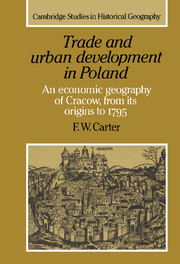Book contents
- Frontmatter
- Contents
- List of figures
- List of tables
- Preface
- Acknowledgements
- 1 Introduction: Cracow in context
- 2 Source materials and published literature
- 3 Cracow's early development
- 4 The political situation of Cracow, 1257–1500
- 5 European trade through Cracow, 1257–1500
- 6 The political situation of Cracow, 1500–1795
- 7 The commerce of Cracow, 1500–1795
- 8 Cracow: a final appraisal
- Appendix: Important dates in Cracow's history up to 1795
- Notes
- Select bibliography
- Index
- Cambridge Studies in Historical Geography
7 - The commerce of Cracow, 1500–1795
Published online by Cambridge University Press: 07 October 2009
- Frontmatter
- Contents
- List of figures
- List of tables
- Preface
- Acknowledgements
- 1 Introduction: Cracow in context
- 2 Source materials and published literature
- 3 Cracow's early development
- 4 The political situation of Cracow, 1257–1500
- 5 European trade through Cracow, 1257–1500
- 6 The political situation of Cracow, 1500–1795
- 7 The commerce of Cracow, 1500–1795
- 8 Cracow: a final appraisal
- Appendix: Important dates in Cracow's history up to 1795
- Notes
- Select bibliography
- Index
- Cambridge Studies in Historical Geography
Summary
The period known as the ‘Golden Age of Cracow’ covered the first half of the sixteenth century and roughly coincided with the reign of King Zygmunt Stary (Sigismund the Old) from 1506 to 1548. The vigorous development of intellectual life in the city, combined with foreign contacts and a flourishing artistic life was supported by commercial prosperity. This was reflected on a larger scale within Poland, expressing itself in the wealth of the country and a favourable growth in foreign trade. Raw materials such as grain, timber, livestock, hemp, flax and potash led to a lively export trade, especially with the Low Countries and England; the production of raw materials, however, was in the hands of the propertied Polish nobility who were gradually becoming farming entrepreneurs. Here one sees the first hint of looming disaster for Cracow, which helped precipitate the city's decline. Not only in Poland but also in other parts of Eastern Europe, the nobility were taking advantage of the rural origins for raw materials such as grain and wresting control of them from urban merchants; in Poland the nobility decisively asserted its dominance over the towns which led to a steady flow of restrictions on the wealth and authority of such places as Cracow. The city also suffered from external factors; the great geographical discoveries had opened up new sea and ocean trade routes, while the old land routes, on which Cracow was so dependent, gradually diminished in importance. Moreover, following the Union of Poland and Lithuania in 1569, Cracow found itself tucked away in the south-west corner of Poland and had to cede its prime position in Poland to Warsaw.
- Type
- Chapter
- Information
- Trade and Urban Development in PolandAn Economic Geography of Cracow, from its Origins to 1795, pp. 195 - 339Publisher: Cambridge University PressPrint publication year: 1994



